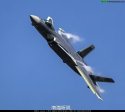I would generally agree with the notion that F-22 and F-35 both have slightly more RCS reduction measures than J-20 for the engine nozzles, which is of course a significant RCS contributor in the rear aspect.
=========
However, I've never been a fan of the term "all aspect stealth," because that term seems to imply that there is such thing as "complete" stealth to begin with, and it also usually goes hand in hand with suggesting an aircraft lacking "all aspect stealth" somehow only has "frontal stealth".
In reality of course, "complete stealth" doesn't exist, and if two stealth aircraft are being compared for their RCS returns then it would have to be done in relation to their practical differences in that aspect, at least for those of us lacking the necessary knowledge and simulators. For J-20, if we are comparing its aft aspect to F-22 or F-35, the most significant difference is J-20 using relatively conventional round nozzles which lack serrations. However, I would strongly argue that such a difference is far from enough to say it "lacks" all aspect stealth or that F-22 or F-35 having a flat or round+serrated nozzle "has" all aspect stealth" because I think one could make a case for just how significant that difference in RCS returns of a conventional nozzle vs a flat or serrated nozzle actually is from a radar in that aft aspect of the plane, to warrant such a major difference in descriptive RCS reduction as saying that one aircraft has "all aspect stealth" while another lacks it.
I would say it is far more sensible to say that aircraft with significant RCS or IR reduction measures for their engine nozzles, compared with aircraft with lesser, few, or no RCS/IR reduction measures for their engine nozzles, should be better described only within the context of their degree of RCS reduction for their overall aft aspect at most... And that might even be pushing it a little considering the aft aspect RCS of a stealth aircraft is also made up other design features like edge alignment, RAM, and overall geometrical design of aft fuselage and things like serrations.
So I'd say it's more accurate to describe the relationship as "J-20 has less aft aspect RCS reduction than F-22" or that "J-20 has less engine RCS reduction than F-22". This might seem like nitpicking, but if one reads those sentences, the meaning it conveys is quite different to saying "F-22 has all aspect stealth while J-20 only has frontal aspect stealth" (paraphrasing kwaig's reply #3952). I do of course agree more with kwaig's reply #3963 where he describes the relationship similar to how I did and is less extreme than using terms like "all aspect stealth" (he did say "Raptor has a lower rear RCS than the J20" which is less extreme), but to be most accurate especially in the complicated aft aspect of an aircraft I think highlighting that the single most major difference is really just the difference in engine nozzles. Engine nozzles are a big contributor in the aft aspect, perhaps even the single largest contributor, but the differences I think are not enough to dominate the discussion about RCS returns in the aft aspect imho.
As for aircraft which are sometimes said to lack "all aspect stealth" (like J-20 or PAK FA or even F-35 in some circles) still retain what I think most people would surmise to be similar RCS reduction profiles to say, F-22, from the side aspects and dorsal aspect, and ventral aspect (depending on the aircraft in question for this last one)... so when "all aspect stealth" is mentioned it is usually a fancier term for "no flat/serrated nozzles"... which I find a bit dubious




